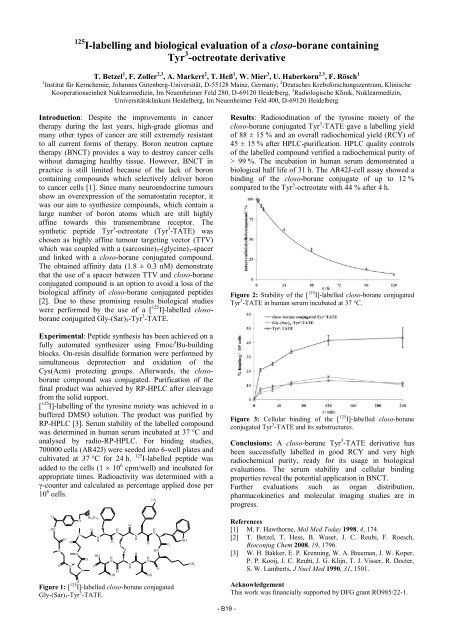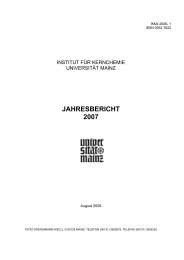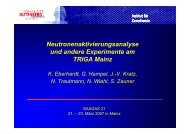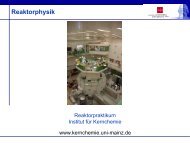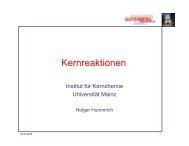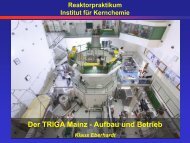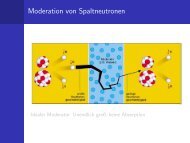institut für kernchemie universität mainz jahresbericht 2009
institut für kernchemie universität mainz jahresbericht 2009
institut für kernchemie universität mainz jahresbericht 2009
Create successful ePaper yourself
Turn your PDF publications into a flip-book with our unique Google optimized e-Paper software.
125 I-labelling and biological evaluation of a closo-borane containing<br />
Tyr 3 -octreotate derivative<br />
T. Betzel 1 , F. Zoller 2,3 , A. Markert 2 , T. Heß 1 , W. Mier 3 , U. Haberkorn 2,3 , F. Rösch 1<br />
1 Institut <strong>für</strong> Kernchemie, Johannes Gutenberg-Universität, D-55128 Mainz, Germany; 2 Deutsches Krebsforschungszentrum, Klinische<br />
Kooperationseinheit Nuklearmedizin, Im Neuenheimer Feld 280, D-69120 Heidelberg, 3 Radiologische Klinik, Nuklearmedizin,<br />
Universitätsklinkum Heidelberg, Im Neuenheimer Feld 400, D-69120 Heidelberg<br />
Introduction: Despite the improvements in cancer<br />
therapy during the last years, high-grade gliomas and<br />
many other types of cancer are still extremely resistant<br />
to all current forms of therapy. Boron neutron capture<br />
therapy (BNCT) provides a way to destroy cancer cells<br />
without damaging healthy tissue. However, BNCT in<br />
practice is still limited because of the lack of boron<br />
containing compounds which selectively deliver boron<br />
to cancer cells [1]. Since many neuroendocrine tumours<br />
show an overexpression of the somatostatin receptor, it<br />
was our aim to synthesize compounds, which contain a<br />
large number of boron atoms which are still highly<br />
affine towards this transmembrane receptor. The<br />
synthetic peptide Tyr 3 -octreotate (Tyr 3 -TATE) was<br />
chosen as highly affine tumour targeting vector (TTV)<br />
which was coupled with a (sarcosine)5-(glycine)1-spacer<br />
and linked with a closo-borane conjugated compound.<br />
The obtained affinity data (1.8 ± 0.3 nM) demonstrate<br />
that the use of a spacer between TTV and closo-borane<br />
conjugated compound is an option to avoid a loss of the<br />
biological affinity of closo-borane conjugated peptides<br />
[2]. Due to these promising results biological studies<br />
were performed by the use of a [ 125 I]-labelled closoborane<br />
conjugated Gly-(Sar)5-Tyr 3 -TATE.<br />
Experimental: Peptide synthesis has been achieved on a<br />
fully automated synthesizer using Fmoc/ t Bu-building<br />
blocks. On-resin disulfide formation were performed by<br />
simultaneous deprotection and oxidation of the<br />
Cys(Acm) protecting groups. Afterwards, the closoborane<br />
compound was conjugated. Purification of the<br />
final product was achieved by RP-HPLC after cleavage<br />
from the solid support.<br />
[ 125 I]-labelling of the tyrosine moiety was achieved in a<br />
buffered DMSO solution. The product was purified by<br />
RP-HPLC [3]. Serum stability of the labelled compound<br />
was determined in human serum incubated at 37 °C and<br />
analysed by radio-RP-HPLC. For binding studies,<br />
700000 cells (AR42J) were seeded into 6-well plates and<br />
cultivated at 37 °C for 24 h. 125 I-labelled peptide was<br />
added to the cells (1 � 10 6 cpm/well) and incubated for<br />
appropriate times. Radioactivity was determined with a<br />
γ-counter and calculated as percentage applied dose per<br />
10 6 cells.<br />
O<br />
HN<br />
N<br />
O<br />
O<br />
O<br />
N<br />
N<br />
O<br />
O<br />
N<br />
N<br />
O<br />
B 10H 10<br />
O<br />
O<br />
N<br />
H<br />
HO<br />
O<br />
H<br />
N<br />
H<br />
N<br />
O<br />
OH<br />
S<br />
S<br />
Figure 1: [ 125 I]-labelled closo-borane conjugated<br />
Gly-(Sar)5-Tyr 3 -TATE.<br />
O<br />
N<br />
H<br />
N<br />
H<br />
O<br />
O<br />
H<br />
N<br />
OH<br />
125 I<br />
H<br />
N<br />
HN<br />
O<br />
O<br />
NH<br />
NH 2<br />
- B19 -<br />
Results: Radioiodination of the tyrosine moiety of the<br />
closo-borane conjugated Tyr 3 -TATE gave a labelling yield<br />
of 88 ± 15 % and an overall radiochemical yield (RCY) of<br />
45 ± 15 % after HPLC-purification. HPLC quality controls<br />
of the labelled compound verified a radiochemical purity of<br />
> 99 %. The incubation in human serum demonstrated a<br />
biological half life of 31 h. The AR42J-cell assay showed a<br />
binding of the closo-borane conjugate of up to 12 %<br />
compared to the Tyr 3 -octreotate with 44 % after 4 h.<br />
Figure 2: Stability of the [ 125 I]-labelled closo-borane conjugated<br />
Tyr 3 -TATE in human serum incubated at 37 °C.<br />
Figure 3: Cellular binding of the [ 125 I]-labelled closo-borane<br />
conjugated Tyr 3 -TATE and its substructures.<br />
Conclusions: A closo-borane Tyr 3 -TATE derivative has<br />
been successfully labelled in good RCY and very high<br />
radiochemical purity, ready for its usage in biological<br />
evaluations. The serum stability and cellular binding<br />
properties reveal the potential application in BNCT.<br />
Further evaluations such as organ distribution,<br />
pharmacokinetics and molecular imaging studies are in<br />
progress.<br />
References<br />
[1] M. F. Hawthorne, Mol Med Today 1998, 4, 174.<br />
[2] T. Betzel, T. Hess, B. Waser, J. C. Reubi, F. Roesch,<br />
Bioconjug Chem 2008, 19, 1796.<br />
[3] W. H. Bakker, E. P. Krenning, W. A. Breeman, J. W. Koper,<br />
P. P. Kooij, J. C. Reubi, J. G. Klijn, T. J. Visser, R. Docter,<br />
S. W. Lamberts, J Nucl Med 1990, 31, 1501.<br />
Acknowledgement<br />
This work was financially supported by DFG grant RO985/22-1.


